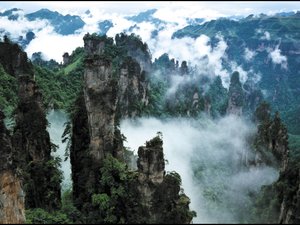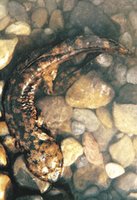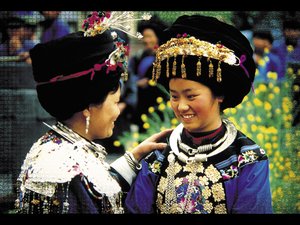Wulingyuan Scenic and Historic Interest Area, China
Contents
- 1 Introduction
- 2 Geographical Location
- 3 Date and History of Establishment
- 4 Area
- 5 Land Tenure
- 6 Altitude
- 7 Physical Features
- 8 Climate
- 9 Vegetation
- 10 Fauna
- 11 Cultural Heritage
- 12 Local Human Population
- 13 Visitors and Visitor Facilities
- 14 Scientific Research and Facilities
- 15 Conservation Value
- 16 Conservation Management
- 17 IUCN Management Category
- 18 Further Reading
Introduction
Wulingyuan Scenic and Historic Interest Area (29°16'-29°24'N, 110°22'-110°41'E) is a World Heritage Site in the Hunan Province of China.
Geographical Location
Lies in Wulingyuan District of the city of Dayong, Hunan Province some 270 kilometers (km) from the capital of Changsha. 29°16'-29°24'N, 110°22'-110°41'E.
Date and History of Establishment
 Peaks at Wulingyuan. (Source: Scottish Information Center)
Peaks at Wulingyuan. (Source: Scottish Information Center) Approved as a scenic and historic interest area by the State Council in 1988, and was placed under the authority of Wulingyuan District Government which was created in the same year. In ancient times, the site was remote, inaccessible and seldom visited; it thus remained almost untouched by man until the founding of People's Republic of China in 1949. Since that time it was under the administration of three county governments, until the Wulingyuan District was established and instructed to take great care to ensure protection, with the closure of some hills to facilitate afforestation. The core zone was inscribed on the World Heritage List in 1992.
Area
26,400 hectares (ha), which is surrounded by a 12,680 ha buffer zone.
Land Tenure
State.
Altitude
Ranges from below 450 meters (m) to 1,264 m (Tuerwangyue Feng or Rabbit Watching the Moon Peak).
Physical Features
The site covers the entire drainage basin of the Suoxi Brook which winds for 69 km through the site. It also covers the headwaters of several other streams. The most notable feature, dominating about two-thirds of the site, is the large number of quartzite sandstone pillars and peaks, of which there are some 3,100, many over 200 m high. They are of a fairly pure composition, being 75-95% of quartz. Between the quartzite layers are a number of layers of extremely thin mica-porphyrite or shale. Layers in the quartzite lie at a fairly oblique angle of 5-8°, which provides vertical stability. Running through this are vertical joints which are a major factor in the formation of these peaks and the gullies between them.
Many of these peaks have been named. Some 85 are listed and described in MoC (1991). Between the peaks are numerous ravines and gorges, many containing attractive streams, pools and waterfalls. The site also contains a number of karst features (about one-third of the site is limestone), notably some 40 caves which are concentrated on the banks of the Suoxiyu River and the south-east side of Tianzi Mountain. Huanglong or Yellow Dragon Cave is said to be one of the ten largest caves in China; it is 11 km long, and includes a waterfall 50 m high. Spectacular calcite deposits are a major feature of many of these caves. There are two spectacular natural bridges in the area: Xianrenqias or 'Bridge of the Immortals' is 26 m long, 1.5-1.8 m wide, 1-2 m thick and 100 m above the gorge. Tianqiashengkong or the 'Bridge Across the Sky' is much larger, being 40 m long, 10 m wide and 15 m thick. It lies 357 m above the valley floor and may be the highest natural bridge in the world.
A number of the numerous brooks and streams flow underground for long distances. The site is popularly known to have '800 brooks and streams'; in reality, there are far less, perhaps 60. Many drain into the Suoxi River which runs through the center of the site. One of the side branches of this river has been dammed at one point, creating Baojeng Lake. This lake has been created for water supply, flood control and to enhance the habitat for the Chinese giant salamander as well as to provide a boating resource.
Climate
Conditions are humid warm-temperate. Mean annual temperature, over a 30-year period, is 16.4°C, with a January mean of 4.8°C and a July mean of 27.3°C. Mean annual rainfall over the same period is 1,427.3 millimeters (mm), with a distinct summer maximum falling between April and August. Snowfall does occur some years and the mean number of frost-free days is 275. Fogs and patchy clouds are a fairly common feature and are renowned for providing a dramatic and ever-varying backdrop to the peaks.
Vegetation
Wulingyuan lies in the Central China Botanic Region of the Sino-Japanese Botanic Zone, and was a refuge for many ancient species during the Quaternary Glacial Era. Below 700 m the community is predominantly evergreen broad-leaf with species such as Ternstroemia gymnatheri, Schima spp., chinquapins Castanopsis spp., Phoebe zhenan (V), Litsea elongata, oak Quercus glaucus, Elaeocarpus spp. and maples Acer spp. Between 700 m and 950 m, there is a mixed community of evergreen and deciduous broad-leaved trees, including oak Quercus spp., tanbark oak Lithocarpus harlandii, and Daphniphyllum spp. There are also some coniferous species including Chinese plum yew Cephalotaxus fortunei and pines Pinus spp. Above 950 m, there is a community of deciduous broad-leaved trees, bushes and herbs, including Clethra faberi, Platycarya strobilacea, Lespedeza bicolor, Quercus spinosa and Rosa henryi. In some areas below 1,000 m, extensive communities are dominated by pine Pinus massoniana.
MoC (1991) indicates that 3,000 species of plant occur within the area, including some 600 species of woody plant (from 252 genera and 94 families); these are split fairly evenly between tropical/subtropical and temperate species. Many of the species are of value for timber, medical or ornamental purposes. Also listed in MoC (1991) are a number of species which are threatened at the international level, including nine rare and three vulnerable species.
Fauna
 Chinese giant salamander. (Source: Scottish Information Center)
Chinese giant salamander. (Source: Scottish Information Center) MoC (1991) lists 116 species of vertebrates from 50 families: 12 amphibians, 17 reptiles, 53 birds and 34 mammals: the total number of vertebrates is undoubtedly higher than this, Thorsell for example states that there are 70 bird species in the site. A number of these species are globally threatened with extinction: Chinese giant salamander Andrias davidianus (I), Asiatic wild dog Cuon alpinus (V), Asiatic black bear Selenarctos thibetanus (V), clouded leopard Neofelis nebulosa (V), leopard Panthera pardus and Chinese water deer Hydropotes inermis (V). The clouded leopard population is likely to be very small, although signs have been found they have never been seen.
Cultural Heritage
Unlike many other areas of China, the site does not have a long human history. In ancient times it was regarded as remote and inaccessible. Local legends indicate that Zhangliang, a lord in the Han Dynasty (206 BC-220 AD), lived in seclusion in Wulingyuan and was buried below Qingyan (now Zhangjiajie) Mountain. Some references to the beauty of the area are made by Liuzhongyuan, a famous Chinese writer of the Tang Dynasty (618-906 AD). From the Ming Dynasty (1368-1644) onwards, the area is mentioned more regularly in official records and in other literature, although most of these refer to the wild nature of the region and the small size of the local population.
Local Human Population
 There is a small population of Maio residents, a minority ethnic group. (Source: Scottish Information Center)
There is a small population of Maio residents, a minority ethnic group. (Source: Scottish Information Center) A number of Shanzhai (mountain strongholds or villages) are situated on peak tops in the area. Many were built in the Ming and Qing Dynasties for their obvious defensive value. They are usually small and some can only be accessed from one or two directions, or by using a rope. Ten such villages are listed in MoC (1991), although none of these is inhabited now.
There is still a resident population in the core area of some 6,600 people: agriculture and pastoralism is practiced, other residents include hotel workers and park staff. Minority ethnic groups found in the site include Tujia and Bai peoples and a smaller Miao population, most of these are found within the buffer zone.
Visitors and Visitor Facilities
The site receives some one million day-visits a year, from 350,000 visitors, who come for an average of three days. Yellow Dragon Cave receives 100,000 visits a year. Of the 18 scenic sections, the 10 most important have been developed for tourism, with three main entrances to the area (at Zhangjiajie, Tianzishan and Souxiyu). Both vehicular and hiking paths have been developed, providing access to some 239 specified natural scenic spots. In an effort to restrict visitor damage, a number of different design approaches have been brought into effect, with vehicles held in the buffer zone and visitors walking, on often very high standard paths, and then using shuttle buses to visit other parts of the area. Other visitors travel in shuttle buses to and from their accommodation in the buffer zone in such centers as Dayong City and Wulinyuan Village. Access from Changsha by road or rail takes a long time, however the construction of an airfield at Dayong (due for completion in 1994) will make the area much more accessible, and will doubtless further intensify visitor pressure. At present the Scenic Area serves mainly domestic users with some visitors from Hong Kong, Macao and Taiwan. Entry to the site is by ticket, so numbers can be counted and controlled if desired. The stated goal for tourism is to achieve quality rather than quantity .
Scientific Research and Facilities
A scientific program is underway, with regular measurements of air and water quality.
Conservation Value
In terms of its large area of massive [[quartz]ite] sandstone peaks, the site presents an unique geomorphological spectacle, which is also of great aesthetic attraction. The site is also important because of its large size and ecological integrity; it contains a number of rare flora and fauna.
Conservation Management
The site is protected under a range of national and regional legislation including: the National Constitution, the Environment Protection Law, the Urbanisation Design Law and the Provisional Regulations of Places of Scenic and Historic Interest. Specific regulations for Wulingyuan itself include; Provisional Measures Concerning the Administration of Wulingyuan Scenic and Historical Interest Area (1989) and the Provisional Regulations Regarding Strengthened Protection of the Wulingyuan Scenic and Historical Interest Area (1991), both issued by the Municipal People's Government of the City of Dayong and the Provincial Regulations Concerning the Control over Sources of Fire in the Open Fields, issued by the District People's Government of Wulingyuan (1991). A number of these State Council regulations are provisional pending review by various ministries, this could take two to three years (from 1992).
Construction projects are considerably restricted. There are a number of restrictions intended to reduce pollution, including the use of certain domestic fuel. Slash and burn agriculture is prohibited. Restrictions are placed on water (Water pollution) pollution, the treatment of solid wastes and noise pollution. The collection of flowers, herbs or plant or animal specimens may only be undertaken with a license for scientific or educational purposes. Felling of trees and quarrying of limestone is restricted, while mining is prohibited.
The Wulingyuan Administrative Bureau has begun to implement a two-part administration plan for the of the site. Measures include raising public awareness, both of the site's beauty and conservation importance. The overall plan for the site subdivides it into 18 scenic sections. A system of zonation has been established, with first, second and third-class conservation sections and a buffer zone. In some areas, tourists will not be allowed access, while access will be restricted in the first and second-class conservation sections. Some hillsides will be closed for further afforestation. Increased training for personnel has been prepared. Tourist numbers may have to be limited, while access to some scenic spots may have to be accompanied by a guide. The growth (Population growth rate) of the local human population may be controlled to reduce the impact on the area. The policy is to control, indeed to reduce, the numbers of people living in all but the buffer zone. In 1992, for example, 16 families were relocated to the buffer zone.
Administrative departments have been established at some of the major sites, such as Huangshi Village, Jinbian Brook, Tianzi Mountain and Baofeng Lake, with the main centre of operations at Wulingyuan village, a servicing center outside the site.
Management Constraints
Tourism had clearly become a threat to the site, but the regulations, management plans and design techniques contain restrictions which should bring this under control. Other potential problems relating to human pressure on the site (both from tourists and the local population) include poaching, land clearance for agriculture, felling of trees, construction of roads and buildings, fire and pollution of air (Air pollution) and water (Water pollution). Again, the regulations and management plan attempt to address this, and most of these threats are concentrated in the buffer zone.
Staff
There are some 1,300 workers, of whom 340 are management staff in the Administrative Departments at Wulingyuan Village and the major scenic spots, such as Huangshi Village, Jinbian Brook, Tianzi Mountain and Baofeng Lake, are in charge of fire prevention and environmental protection.
Budget
Approximately Yen 5 million, of which approximately 1.5 million is ongoing annual expenditure, with the balance being capital expenditure.
IUCN Management Category
- V (Protected Landscape)
- Natural World Heritage Site - Criterion iii
Further Reading
MoC (1991). World Heritage Convention, Natural Heritage: China. Wulingyuan. Nomination for World Heritage listing prepared by the Construction Ministry of the People's Republic of China. 143 pp.
| Disclaimer: This article is taken wholly from, or contains information that was originally published by, the United Nations Environment Programme-World Conservation Monitoring Centre (UNEP-WCMC). Topic editors and authors for the Encyclopedia of Earth may have edited its content or added new information. The use of information from the United Nations Environment Programme-World Conservation Monitoring Centre (UNEP-WCMC) should not be construed as support for or endorsement by that organization for any new information added by EoE personnel, or for any editing of the original content. |